How To See Computer Temperature Windows 10
Is your computer'south CPU also hot? If your PC starts spontaneously shutting downward, locking upwardly, or acting sluggish during intense tasks, overheating could be the outcome. Keeping tabs on your CPU temperatures is crucial when you're overclocking your PC'due south processor, too—you lot don't want to accidentally push the performance pedal too far to the metal when you lot're supercharging your pricey Core i9-12900K or AMD Ryzen 5900X, specially given how hard it is to larn processors these days. Melting one of the best CPUs effectually is ever a bummer.
Bizarrely, Windows doesn't offer any way to cheque your calculator's CPU temperature. You could swoop into your organisation's BIOS to notice the data, simply that'south a lot of hassle to detect a uncomplicated sensor reading. Fortunately, several free programs be that make it piece of cake to encounter your processor'due south temperature.
How to check your CPU temperature
The fastest, easiest fashion to check your CPU temp is using the aptly named Core Temp. Be mindful during installation though! Similar many free programs, it tries to install bloatware unless you uncheck some boxes during setup.
Once installed, open Core Temp to encounter a no-frills look at the electric current state of your CPU, including an boilerplate temperature reading at the lesser of the window. If you lot want even more particular, click the Bear witness hidden icons push button in the system tray located at the right border of your Windows taskbar. You'll see a temperature listing for every individual CPU core in your calculator.
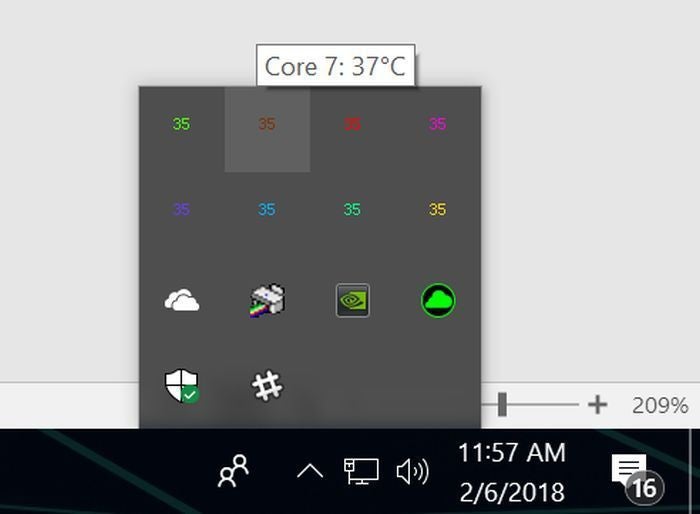
Per-core CPU temperature readings provided by the Core Temp app.
Core Temp's Settings menu allows y'all to tweak exactly what you lot'll see in the system tray, and how you'll run across it, but the default configuration makes information technology dead-simple to encounter if your CPU is overheating or performing as expected.
Core Temp isn't the only option though. HWInfo is an in-depth system monitoring tool that provides deep details about every piece of your PC's hardware. If you choose to run it in sensors-simply mode, scrolling down to the CPU section—the dedicated section, not the CPU temperature portion of the motherboard list—reveals current temps and other nitty-gritty details.
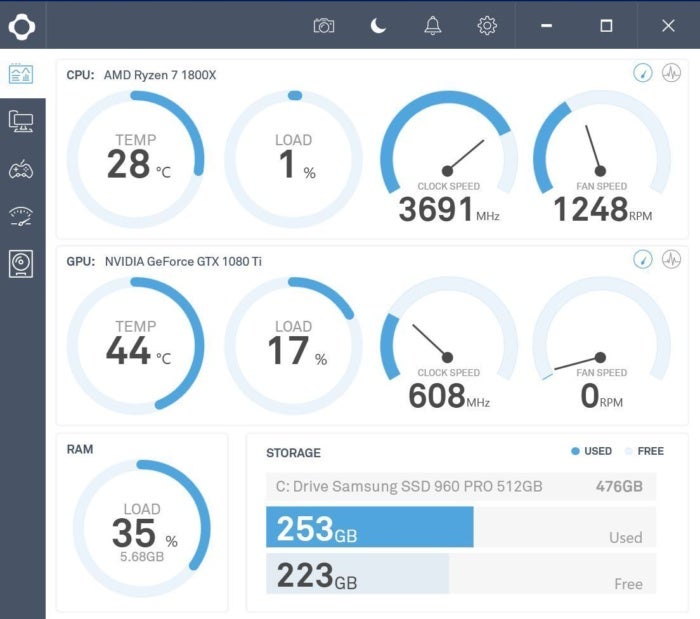
NZXT's Cam monitoring software.
NZXT's Cam software is some other pop option with a diverse skillset. Its slick interface is easier to read at a glance than those on most other monitoring tools, and the plan shows all sorts of useful info virtually your CPU, graphics card, memory, and storage. Cam also includes an in-game FPS overlay and overclocking tools, among other features. You can utilise NZXT's Cam mobile apps to continue tabs on your software when y'all're away from your PC, too.
Open Hardware Monitor and SpeedFan are other well-regarded monitoring tools that can track organisation information. You've got options! Merely for simply checking your computer's CPU temperatures, Core Temp's straightforward focus tin't be beat.
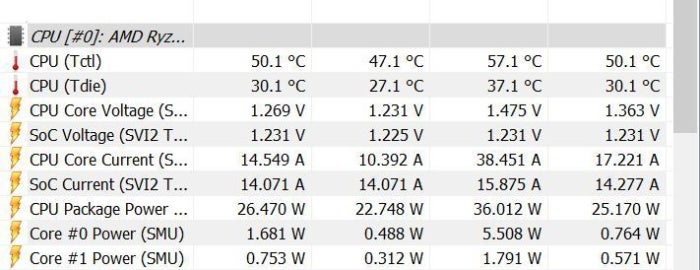
If monitoring software (like HWInfo here) displays two CPU temperatures for Ryzen processors, look for the "Tdie" reading.
Finally, annotation that if you're running an AMD Ryzen organisation, including 3rd-gen models like the ferocious Ryzen 9 5900X or the more modest Ryzen 5 5600X that's the best gaming processor for most people, y'all may see two unlike CPU temperature readings. You desire the "Tdie" reading, depending on how the program you're using displays the info. It'southward a measurement of the actual heat on the die.
The alternative "Tctl" reading is the control temperature reported to your cooling arrangement and sometimes includes a temperature starting time to ensure universal fan speed behavior between the various Ryzen chips. Whatsoever of the programs above that list a unmarried temperature business relationship for the beginning already.
What's the best temp for your CPU?
The maximum supported temperature varies from processor to processor. Most of the gratuitous monitoring software mentioned above lists the information as "Tj. Max." That stands for the temperature junction, or the highest operating temperature of the hardware. If you don't see the data for some reason, search the CPU World website for your CPU's model number to find the information. Every program listed above displays your processor's model number, and so it'southward easy to find.
But that's the maximum temperature—the point at which your processor freaks out and shuts downwards to avoid damage. Running anywhere near that hot regularly is bad for the long-term life of your hardware. Instead, follow this general rule of thumb regarding CPU temperatures nether load.
- Under sixty° C: You're running great!
- 60° C to lxx° C: Nevertheless running fine, merely getting a scrap warmer. Consider cleaning the dust out of your PC if CPU temperatures continue to pitter-patter upwardly over time.
- seventy° C to 80° C: This is hotter than you want to run unless you lot're pushing an overclock. If you're not, definitely cheque to make sure your fans are working and there aren't dust bunnies bottleneck up your system's airflow.
- eighty° C to xc° C: Now nosotros're getting too hot for long-term comfort. Check your hardware for broken fans or dust build-up, and if yous're overclocking, dial back your settings—especially the voltage if yous've tweaked it. Ane notable exception: We sometimes encounter more powerful laptop processors striking the low 80s during gaming sessions when plugged in, at which point they showtime throttling back functioning. This is expected, just if temperatures cross 85° C, be concerned.
- Over 90° C: Danger, Volition Robinson!
How to lower your CPU temperatures
If you're regularly encountering loftier CPU temperatures, there are some steps you can take to try and fix the upshot.
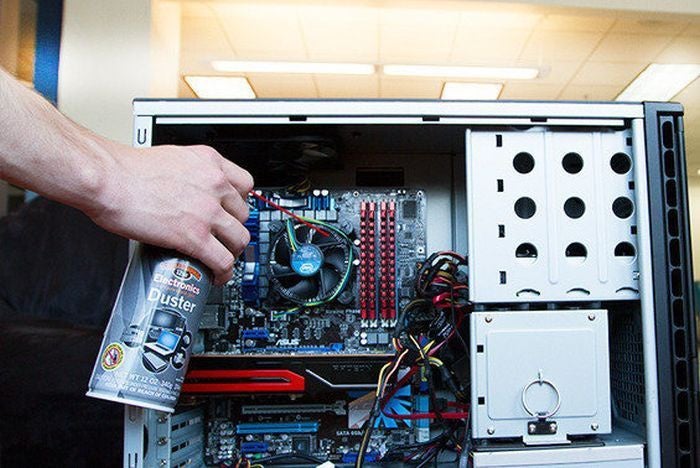
Roll up your sleeves.
Commencement, clean out your PC. High CPU temperatures are often caused by years of dust and grime built upward within a PC, clogging fans and crucial air pathways. Local hardware stores usually charge outrageous prices for canned air, but you tin pick up a bottle for near $eight on Amazon. PCWorld's guide on how to clean your PC tin can walk you through the process. While you're at information technology, cheque to make sure that all your fans are working correctly, pointed the right way, and that none of the vents in your PC are blocked. (Also, brand sure your PC's fans are set up for maximum cooling functioning.)
Hopefully that fixes the issue. If not, more than intensive steps are in order. The thermal paste that transfers estrus from your CPU to its cooler might have stale out if you've had your PC for a few years. That tin can crusade temperature spikes.
Removing the erstwhile thermal paste with rubbing alcohol and applying a fresh layer tin can potentially help lower temperatures past a large amount. You can find pocket-sized syringes of thermal paste by respected brands like Arctic and Noctua for under $10 on Amazon. (I've been a happy Arctic Silver five user for years now.)
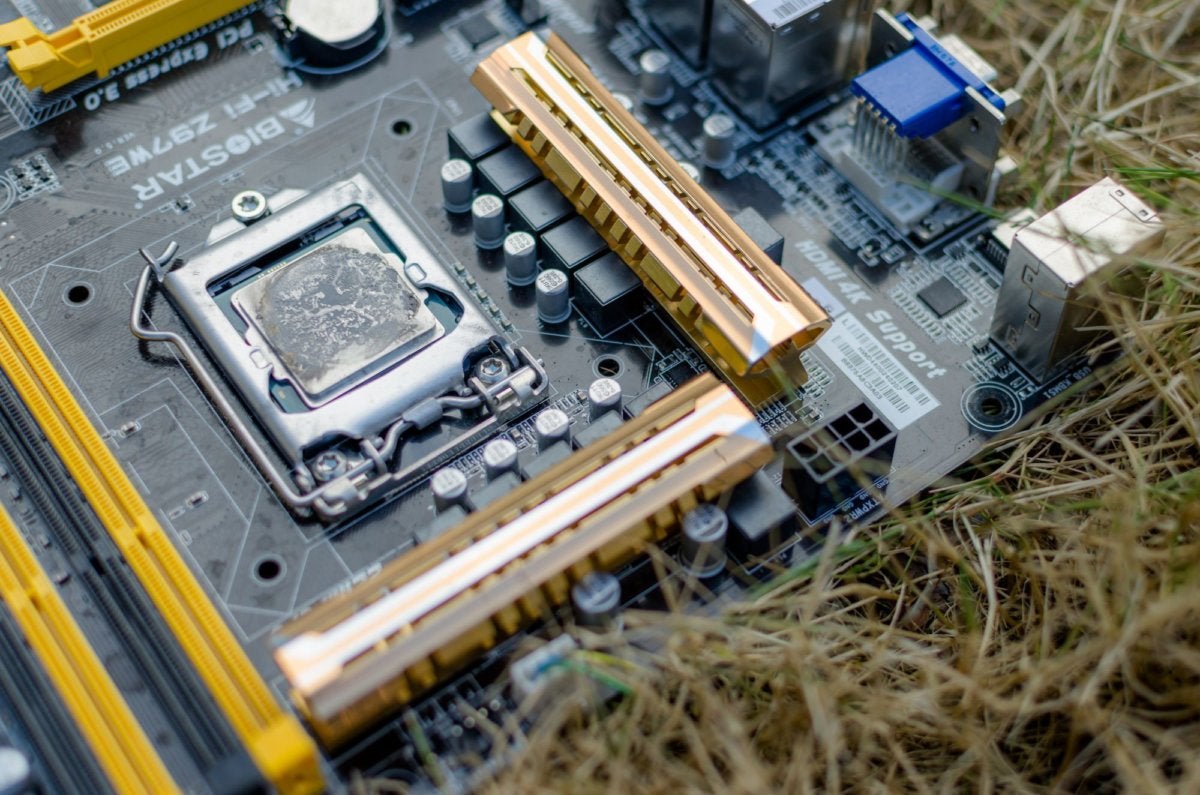
If all that doesn't aid, your cooling solution merely might non exist capable of keeping upward with your CPU's heat output, especially if you lot're pairing a stock cooler or a modest third-party cooler with college-end chips—and doubly and then if y'all're overclocking. Buying a new CPU cooler may be in lodge.
The Cooler Primary Hyper 212 ($50 on Amazon) is a solid, affordable air cooler. With its larger heatsink and fan, it's a solid pace upwards over stock AMD and Intel CPU coolers. Moving up in size and price, the Noctua NH-D15 ($100 on Amazon) is ane of the well-nigh effective air coolers ever to hit the streets, just its large size might block memory access or not fifty-fifty fit in smaller cases.
Closed-loop liquid cooling solutions (CLCs) provide far libation temperatures than air coolers with minimal hassle and easy installation. EVGA'southward 120mm unit ($threescore on Amazon) is a great entry-level CLC, but if you plan on overclocking, consider moving up to a model with larger 240mm radiator, like the straightforward-named EVGA CLC 280 ($90 on Amazon). Several brands are available, simply we've been using EVGA'due south closed-loop coolers in PCWorld's powerful, defended graphics carte testing system to swell results.
Nosotros're also partial to the even larger 280mm NZXT Kraken X63 ($150 on Amazon). All that extra metal and fans can accommodate the fiercest overclocks.
Note: When yous purchase something after clicking links in our articles, we may earn a small commission. Read our affiliate link policy for more details.
How To See Computer Temperature Windows 10,
Source: https://www.pcworld.com/article/407914/how-to-check-your-cpu-temperature.html
Posted by: weaverabsetiley.blogspot.com


0 Response to "How To See Computer Temperature Windows 10"
Post a Comment